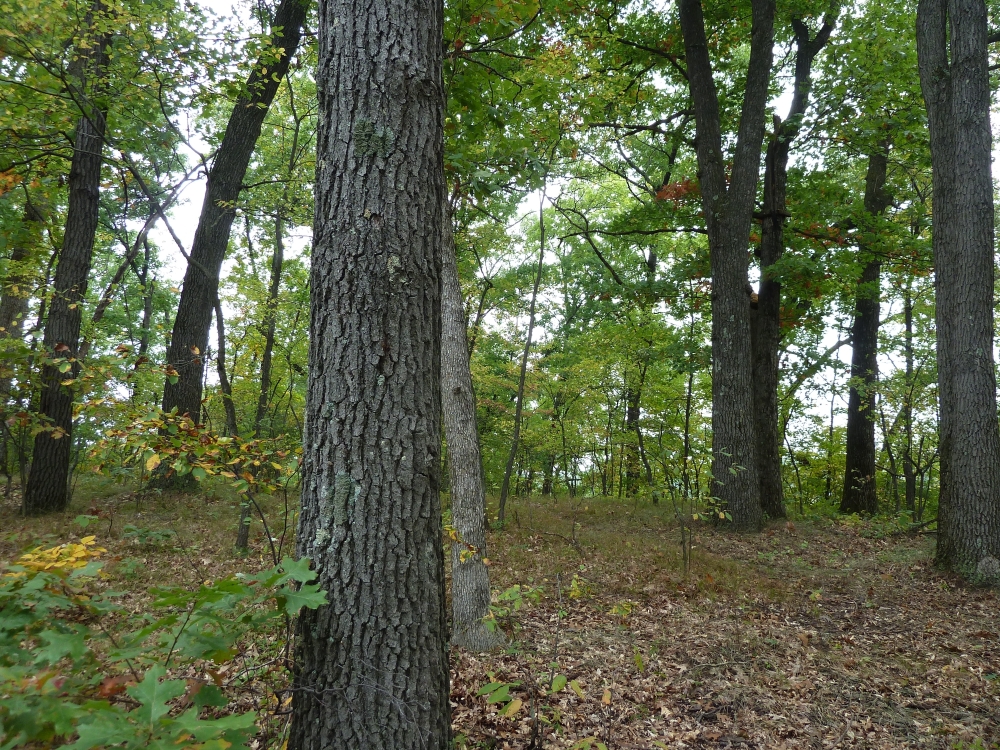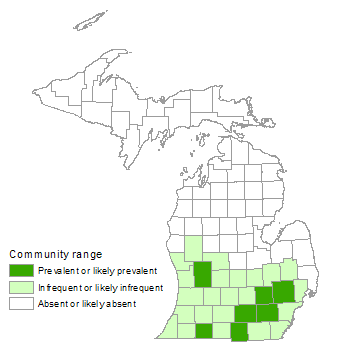Dry Southern Forest
Overview
Dry southern forest is a fire-dependent, oak-dominated forest type on dry sites lying mostly south of the climatic tension zone in southern Lower Michigan. Frequent fires maintain semi-open conditions, promoting oak regeneration and ground and shrub layer diversity.
Rank
Global Rank: G4 - Apparently secure
State Rank: S3 - Vulnerable

Landscape Context
The community occurs principally on glacial outwash, and less frequently on sand dunes, sandy glacial lakeplains, and coarse-textured moraines. Dry southern forest typically occurs in conjunction with other fire-dependent upland and wetland communities such as dry-mesic southern forest, oak barrens, dry sand prairie, coastal plain marsh, southern wet meadow, and prairie fen.
Soils
The soils of dry southern forest are infertile, well-drained sand, loamy sand, or sandy loam with medium to strongly acid pH and low water-retaining capacity.
Natural Processes
Fire, windthrow, and insect outbreaks and pathogens associated with oak defoliation and decline are the prevalent natural disturbance factors influencing dry southern forest. In addition, low-productivity droughty soils also play a significant role in structuring the community. Historically, frequent low-intensity surface fires generated conditions suitable for sustaining advanced oak regeneration and helped keep oak pathogens and invertebrate acorn predators at low levels. Tree density in circa 1800 oak forests was likely lower than that observed today under conditions of fire suppression, and helped limit root-grafting and the spread of several oak pathogens. Frequent small-scale wind disturbance or gap-phase dynamics allows for growth of suppressed oak saplings and canopy ascension of understory oaks. Prolonged periods of fire suppression in oak barrens can result in succession to closed-canopy, dry southern forest and likely accounts for the existence of many oak forests observed today.
Vegetation
The canopy layer generally is dominated or codominated by black oak (Quercus velutina) and white oak (Q. alba). Prevalent canopy associates include pignut hickory (Carya glabra), red maple (Acer rubrum), black cherry (Prunus serotina), and sassafras (Sassafras albidum). Northern pin oak (Q. ellipsoidalis) is present on the driest sites close to the tension zone. Prevalent species of the subcanopy layer include flowering dogwood (Cornus florida), American hazelnut (Corylus americana), cherries (Prunus spp.), and sassafras (Sassafras albidum). Characteristic shrubs include serviceberries (Amelanchier spp.), New Jersey tea (Ceanothus americanus), low sweet blueberry (Vaccinium angustifolium), velvetleaf blueberry (Vaccinium myrtilloides), gray dogwood (Cornus foemina), American hazelnut (Corylus americana), hawthorns (Crataegus spp.), huckleberry (Gaylussacia baccata), witch hazel (Hamamelis virginiana), choke cherry (Prunus virginiana), and blackberries (Rubus spp.). Typical herbaceous species include hog peanut (Amphicarpaea bracteata), wild geranium (Geranium maculatum), beggars lice (Hackelia virginiana), woodland sunflower (Helianthus divaricatus), whorled yellow loosestrife (Lysimachia quadrifolia), false Solomon's seal (Maianthemum racemosum), wintergreen (Gaultheria procumbens), and summer grape (Vitis aestivalis).
For information about plant species, visit the Michigan Flora website.
Plant Lists
Graminoids
- wavy hair grass (Avenella flexuosa)
- long-awned wood grass (Brachyelytrum erectum)
- sedges (Carex cephalophora, C. muehlenbergii, C. pensylvanica, and others)
- poverty grass (Danthonia spicata)
Forbs
- hog-peanut (Amphicarpaea bracteata)
- false foxgloves (Aureolaria spp.)
- large-leaved aster (Eurybia macrophylla)
- wild geranium (Geranium maculatum)
- beggars lice (Hackelia virginiana)
- woodland sunflower (Helianthus divaricatus)
- pointed-leaf tick-trefoil (Hylodesmum glutinosum)
- naked-flower tick-trefoil (Hylodesmum nudiflorum)
- pale vetchling (Lathyrus ochroleucus)
- four-leaved loosestrife (Lysimachia quadrifolia)
- Canada mayflower (Maianthemum canadense)
- false spikenard (Maianthemum racemosum)
- black snakeroots (Sanicula spp.)
- bluestem goldenrod (Solidago caesia)
- yellow-pimpernel (Taenidia integerrima)
- pale vetch (Vicia caroliniana)
Woody Vines
- summer grape (Vitis aestivalis)
Shrubs
- serviceberries (Amelanchier spp.)
- New Jersey tea (Ceanothus americanus)
- spotted wintergreen (Chimaphila maculata)
- pipsissewa (Chimaphila umbellata)
- gray dogwood (Cornus foemina)
- American hazelnut (Corylus americana)
- hawthorn (Crataegus spp.)
- wintergreen (Gaultheria procumbens)
- huckleberry (Gaylussacia baccata)
- witch-hazel (Hamamelis virginiana)
- sand cherry (Prunus pumila)
- choke cherry (Prunus virginiana)
- common blackberry (Rubus allegheniensis)
- northern dewberry (Rubus flagellaris)
- low sweet blueberry (Vaccinium angustifolium)
- Canada blueberry (Vaccinium myrtilloides)
- hillside blueberry (Vaccinium pallidum)
Trees
- red maple (Acer rubrum)
- serviceberries (Amelanchier arborea, A. interior, and A. laevis)
- pignut hickory (Carya glabra)
- flowering dogwood (Cornus florida)
- hawthorns (Crataegus spp.)
- black cherry (Prunus serotina)
- white oak (Quercus alba)
- northern pin oak (Quercus ellipsoidalis)
- black oak (Quercus velutina)
- sassafras (Sassafras albidum)
Noteworthy Animals
The now extinct passenger pigeon (Ectopistes migratorius) was likely a keystone species in oak ecosystems, roosting in oak forests by the thousands.
Rare Plants
- Angelica venenosa (hairy angelica, state special concern)
- Baptisia leucophaea (cream wild indigo, state endangered)
- Celtis tenuifolia (dwarf hackberry, state special concern)
- Dennstaedtia punctilobula (hay-scented fern, state threatened)
- Geum virginianum (pale avens, state special concern)
- Houstonia caerulea (bluets, state special concern)
Rare Animals
- Accipiter cooperii (Cooper’s hawk, state special concern)
- Sistrurus c. catenatus (eastern massasauga, federal candidate species and state special concern)
- Terrapene c. carolina (eastern box turtle, state special concern)
Biodiversity Management Considerations
Fire is the single most significant factor in preserving oak ecosystems. The use of prescribed fire is an imperative management tool for promoting oak regeneration and deterring the succession of shade-tolerant species and encroachment by invasive shrubs. Fire management should be orchestrated in conjunction with management of adjacent fire-dependent communities such as oak barrens, dry sand prairie, prairie fen, and coastal plain marsh. Many dry southern forests represent degraded oak barrens that have been long deprived of fire. Open canopy conditions can be restored by mechanical thinning or girdling of understory and overstory trees. Restored sites can be maintained by periodic prescribed fire and may require investment in native plant seeding where seed and plant banks are inadequate.
Monitoring and control efforts to detect and remove invasive species are critical to the long-term viability of dry southern forest. Invasive species that threaten the diversity and community structure include garlic mustard (Alliaria petiolata), black swallow-wort (Vincetoxicum nigrum), white swallow-wort (V. rossicum), Oriental bittersweet (Celastrus orbiculatus), common buckthorn (Rhamnus cathartica), autumn olive (Elaeagnus umbellata), Eurasian honeysuckles (especially Lonicera morrowii, L. tatarica, and L. xbella), and multiflora rose (Rosa multiflora).
Variation
Toward the transition zone, white pine (Pinus strobus) becomes a constant canopy associate.
Similar Natural Communities
Oak barrens, oak-pine barrens, dry-mesic southern forest, dry northern forest, and dry-mesic northern forest.
Places to Visit
- Bassett Lake Woods, Barry State Game Area, Barry Co.
- Crooked Lake Forest, Waterloo State Recreation Area, Jackson Co. and Washtenaw Co.
- Moeckel Road Woods, Waterloo State Recreation Area, Jackson Co.
Relevant Literature
- Abrams, M.D. 1992. Fire and the development of oak forests. BioScience 42(5): 346-353.
- Anderson, M.D., and L.E. Brown. 1983. Comparative effects of fire on trees in a Midwestern savannah and an adjacent forest. Bulletin of the Torrey Botanical Club 119(1): 19-28.
- Brewer, L.G., T.W. Hodler, and H.A. Raup. 1984. Presettlement vegetation of southwestern Michigan. Michigan Botanist 23(4): 153-156.
- Cottam, G. 1949. The phytosociology of an oak woods in southwestern Wisconsin. Ecology 30(3): 271-287.
- Curtis, J.T. 1959. The vegetation of Wisconsin. University of Wisconsin Press, Madison, WI. 657 pp.
- Minc, L.D., and D.A. Albert. 1990. Oak-dominated communities of southern Lower Michigan: Floristic and abiotic comparisons. Michigan Natural Features Inventory, Lansing, MI. Unpublished manuscript. 103 pp.
- Rodewald, A.D. 2003. Decline of oak forests and implications for forest wildlife conservation. Natural Areas Journal 23(4): 368-371.
Citation
Cohen, J.G., M.A. Kost, B.S. Slaughter, D.A. Albert, J.M. Lincoln, A.P. Kortenhoven, C.M. Wilton, H.D. Enander, and K.M. Korroch. 2020. Michigan Natural Community Classification [web application]. Michigan Natural Features Inventory, Michigan State University Extension, Lansing, Michigan. Available https://mnfi.anr.msu.edu/communities/classification. (Accessed: April 19, 2024).
Kost, M.A., D.A. Albert, J.G. Cohen, B.S. Slaughter, R.K. Schillo, C.R. Weber, and K.A. Chapman. 2007. Natural Communities of Michigan: Classification and Description. Michigan Natural Features Inventory, Report No. 2007-21, Lansing, MI.


